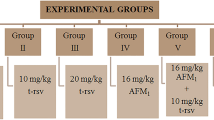Abstract
AFLATOXIN B1 (AFB1) has the highest biological activity of the four naturally occurring aflatoxins produced by the mould Aspergillus flavus1. Feeding studies have shown it to be the most potent liver carcinogen known for the rat2. Its ingestion by man is associated with the high primary liver cancer incidence in certain parts of Africa3. There is much evidence to suggest that AFB1 requires metabolism to exert both its carcinogenic and mutagenic effects (reviewed in ref. 4). Structure-activity5, as well as chemical studies6,7 indicate that the major route for activation proceeds through mixed function oxidase attack yielding the 8,9-oxide (previously called the 2,3-oxide but renumbered according to IUPAC recommendations). Attempts to chemically synthesise this metabolite have so far been unsuccessful. We report here that peracid oxidation of AFB1 generates AFB1-8,9-oxide, and that this latter compound reacts readily with nucleic acids to give adducts identical to those obtained after liver mixed function oxidase (MFO) activation in vitro and in vivo.
This is a preview of subscription content, access via your institution
Access options
Subscribe to this journal
Receive 51 print issues and online access
$199.00 per year
only $3.90 per issue
Buy this article
- Purchase on Springer Link
- Instant access to full article PDF
Prices may be subject to local taxes which are calculated during checkout
Similar content being viewed by others
References
Wogan, G. N. in Methods in Cancer Research (ed. Busch, H.) 309–344 (Academic, New York,1973).
Wogan, G. N., Paglialunga, S. & Newberne, P. M., Fd. Cosmet. Toxicol. 12, 681–685 (1974).
Peers, F. G., Gilman, G. A. & Linsell, C. A., Int. J. Cancer 17, 167–176 (1976).
Campbell, T. C. & Hayes, J. R., Toxicol. appl. Pharm. 35, 199–222 (1976).
Garner, R. C., Miller, E. C. & Miller, J. A., Cancer Res. 32, 2058–2066 (1972).
Swenson, D. H., Miller, E. C. & Miller, J. A., Biochem. biophys. Res. Commun. 60, 1036–1043 (1974).
Garner, R. C., FEBS Lett. 36, 261–264 (1973).
Anderson, W. K. & Veysoglu, T., J. Org. Chem. 38, 2267–2268 (1973).
Miller, C. T., Lawley, P. D. & Shah, S. A., Biochem. J. 136, 387–393 (1973).
Lawley, P. D. & Thatcher, C. A., Biochem. J. 116, 693–707 (1970).
Lawley, P. D. & Brookes, P., Biochem. J. 89, 127–138 (1963).
Lawley, P. D. & Shah, S. A., Chem.-Biol. Interact. 7, 115–120 (1973).
Swenson, D. H., Lin, J. K., Miller, E. C. & Miller, J. A., Cancer Res. 37, 172–181 (1977).
Garner, R. C., Chem.-Biol. Interact. 6, 125–129 (1973).
Author information
Authors and Affiliations
Additional information
The erratum article can be found online at https://doi.org/10.1038/269450d0
Rights and permissions
About this article
Cite this article
MARTIN, C., GARNER, R. Aflatoxin B-oxide generated by chemical or enzymic oxidation of aflatoxin B1 causes guanine substitution in nucleic acids. Nature 267, 863–865 (1977). https://doi.org/10.1038/267863a0
Received:
Accepted:
Published:
Issue Date:
DOI: https://doi.org/10.1038/267863a0
This article is cited by
-
Integrated small RNA and mRNA expression profiles reveal miRNAs and their target genes in response to Aspergillus flavus growth in peanut seeds
BMC Plant Biology (2020)
-
Mode of action-based risk assessment of genotoxic carcinogens
Archives of Toxicology (2020)
-
Genetics of hepatocellular tumors
Oncogene (2006)
-
Intercellular variation in levels of adducts of aflatoxin B1 and G1 in DNA from rat tissues: a quantitative immunocytochemical study
Journal of Cancer Research and Clinical Oncology (1990)
Comments
By submitting a comment you agree to abide by our Terms and Community Guidelines. If you find something abusive or that does not comply with our terms or guidelines please flag it as inappropriate.



